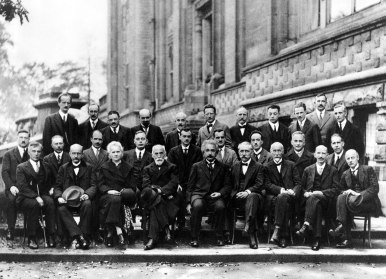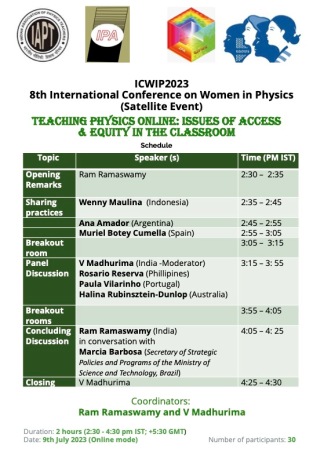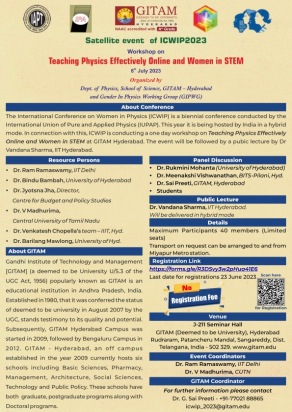 When the first Solvay Conference was organized in 1911 to discuss current problems in Physics and Chemistry, Marie Curie was the only woman invited. It probably took her 1903 Nobel prize in physics to secure her place at the table, though in all fairness, many (but not all) of the men there were Nobel laureates.
When the first Solvay Conference was organized in 1911 to discuss current problems in Physics and Chemistry, Marie Curie was the only woman invited. It probably took her 1903 Nobel prize in physics to secure her place at the table, though in all fairness, many (but not all) of the men there were Nobel laureates.
 Sixteen years later, when the fifth Solvay was held in 1927, she still was the only woman at the meeting although by then she had her second Nobel prize (in chemistry, in 1911). There were some other women who might have been invited to the meeting on quantum physics – Lise Meitner had been appointed Professor of Physics in Berlin in 1926 (she would go on to discover nuclear fission) and the mathematician Emmy Noether who made seminal contributions in mathematical physics. There may have been others as well, but the bar had been set high: the next woman to be awarded the Nobel prize in physics was Maria Goeppert-Mayer, in 1963…
Sixteen years later, when the fifth Solvay was held in 1927, she still was the only woman at the meeting although by then she had her second Nobel prize (in chemistry, in 1911). There were some other women who might have been invited to the meeting on quantum physics – Lise Meitner had been appointed Professor of Physics in Berlin in 1926 (she would go on to discover nuclear fission) and the mathematician Emmy Noether who made seminal contributions in mathematical physics. There may have been others as well, but the bar had been set high: the next woman to be awarded the Nobel prize in physics was Maria Goeppert-Mayer, in 1963…
Things did not change as rapidly as one might have hoped in the following decades. Few women were able to break through the various barriers that anybody, regardless of gender, needed to in order for them to have research careers in physics. Some of the causes for the low representation were poorly understood till recently, when the role of bias, both explicit and innate became quantified. In an article in the New York Times in 2013 Eileen Pollack asked Why Are There Still So Few Women in Science? where she also gave some answers. Women aiming to have a research career in physics get little encouragement, experience considerable bias in the workplace, in addition to the considerable cultural bias that exists in most societies. It is interesting to note that when Pollack graduated from Yale in 1978 with an undergraduate degree in Physics, she was the only woman in her class. In 1953, Sheila Prasad was similarly the only woman in her BSc Physics class at Mysore University, but that was twenty-five years earlier, and in India!
 But this post is mainly about a Conference and some Workshops that will be held in the coming week that relate to this issue. The International Union of Pure and Applied Physics (or IUPAP) which in some sense represents physicists worldwide decided to create a Women in Physics (WiP) Working Group (WG5) in 1999 with the main aim being to suggest means to “improve the situation for women in physics. Since this is a global organization, the hope was to use the strength of numbers to address an issue that did not seem to change over the years
But this post is mainly about a Conference and some Workshops that will be held in the coming week that relate to this issue. The International Union of Pure and Applied Physics (or IUPAP) which in some sense represents physicists worldwide decided to create a Women in Physics (WiP) Working Group (WG5) in 1999 with the main aim being to suggest means to “improve the situation for women in physics. Since this is a global organization, the hope was to use the strength of numbers to address an issue that did not seem to change over the years
One of the main activities of WG5 is to organize a conference every three years, and this year, the 8th International Conference of Women in Physics, ICWIP8 will be hosted by India from 10 to 14 July. Memories of the pandemic and lockdowns have made this meeting an entirely online affair, but having attended an earlier ICWIP in Stellenbosch, South Africa, I know the energy and vitality of an in-person conference where women are in the majority in all senses of the term.
 WG5 has taken more onto its plate and now this group is also given the task of suggesting means to increase gender diversity and inclusion in the practice of physics and to promote and take actions to increase gender diversity and inclusion across countries and regions. One of the outcomes of the general global awareness was the creation of the Gender in Physics Working Group (GIPWG) of Indian Physics Association (IPA), the main moving force behind the push to bring this conference to India.
WG5 has taken more onto its plate and now this group is also given the task of suggesting means to increase gender diversity and inclusion in the practice of physics and to promote and take actions to increase gender diversity and inclusion across countries and regions. One of the outcomes of the general global awareness was the creation of the Gender in Physics Working Group (GIPWG) of Indian Physics Association (IPA), the main moving force behind the push to bring this conference to India.
Having been part of the country team in the past, the opportunity to do something substantial at this meeting of the ICWIP has been very tempting, and along with Professor Madhurima of the Department of Physics, Central University of Tamil Nadu, two workshops are being organized at GITAM University in Hyderabad.
 Teaching Physics Online: Issues of Access & Equity in the Classroom will be an online meeting from 2:30-4:30 pm IST on Sunday, 9th July. Since the theme for the International Women’s Day 2023 was specified by the UN to be DigitAll – Innovation and technology for gender equality, this seemed like a good discussion point, especially since already before the COVID-19 pandemic hit the globe, education was leaning towards online modes through the use of MOOCs. Post-pandemic, online education is here to stay. In India, this is reflected in the National Education Policy 2020 which has a large online education component. On the one hand there is a noticeable gender inequity in access to digital devices and internet, and on the other hand, the amount of time available to women teachers (and students) is restricted by societal norms.
Teaching Physics Online: Issues of Access & Equity in the Classroom will be an online meeting from 2:30-4:30 pm IST on Sunday, 9th July. Since the theme for the International Women’s Day 2023 was specified by the UN to be DigitAll – Innovation and technology for gender equality, this seemed like a good discussion point, especially since already before the COVID-19 pandemic hit the globe, education was leaning towards online modes through the use of MOOCs. Post-pandemic, online education is here to stay. In India, this is reflected in the National Education Policy 2020 which has a large online education component. On the one hand there is a noticeable gender inequity in access to digital devices and internet, and on the other hand, the amount of time available to women teachers (and students) is restricted by societal norms.
In this workshop, an international panel of speakers will discuss the extent to which undergraduate and postgraduate Physics education can be delivered online, in an environment that cannot be accessed equally by all. In order to bring different experiences to the table, we have invited seven physicists (all Professors) from universities across the world, Wenny Maulina (University of Jember, Indonesia), Ana Amador (University of Buenos Aires, Argentina), Muriel Botey Cumella (Universitat Politècnica de Catalunya, Spain), Rosario Reserva (Mindanao State University-Iligan Institute of Technology, Philippines), Paula Vilarinho (University of Aveiro, Portugal), Halina Rubinsztein Dunlop (U Queensland, Australia) and Marcia Barbosa, the Vice-Minister for Strategic Policies and Programs of the Ministry of Science and Technology, Brazil (and on the faculty of Federal University of Rio Grande do Sul) to share their points of view about how effective (or ineffective) the teaching of Physics can be via the online mode. Hopefully we will probe the nature of learning in this new environment and the efficacy of evaluation online and the role of academic administrators in ensuring quality online education. Since it is all online, location is hardly an issue, but fact of the matter is that both organisers of the satellite meeting will be at GITAM. But there is more-
The pandemic (remember those days? The son et lumière?) made all education online, and during the darkest of those days, Prof. Madhurima and I set up the Discussion Forum for Online Teachers or DFOT, through which we tried to get the community of teachers to talk about the different strategies we all used during those days. The Panel Discussions explored a variety of topics, including
- How to Engage Students in Online Classes
- Ways of Evaluating Online Classes
- Online Teaching: The Role of Administration
- Challenges of Teaching Mathematics and mathematical Physics Online
- Virtual Labs and online Field work
- Online Teaching & Persons with Disabilities
- Advantages of Online Higher Education
 I’ve written about DFOT on this blog before, but one thing we thought was whether we could use the occasion of ICWIP to have a discussion with physics teachers in India on just how effective the online medium can be when there is no pandemic to worry about, and what the gender dimension is in practice. On the 8th of July, we will have a Workshop on Teaching Physics Effectively Online an in-person meeting at GITAM. Teachers who are participating in the discussion include Bindu Bambah, Rukmani Mohanta, Barilong Mawlong (all from the University of Hyderabad), Venkatesh Chopella (IIIT) Meenakshi Viswanathan (BITS-Pilani) and Sai Preeti (GITAM). There will also be a hybrid lecture by Vandana Sharma of the IIT Hyderabad on Imaging assisting Humankind: Fundamental Science to Application and hopefully there will be a link to the online talk here.
I’ve written about DFOT on this blog before, but one thing we thought was whether we could use the occasion of ICWIP to have a discussion with physics teachers in India on just how effective the online medium can be when there is no pandemic to worry about, and what the gender dimension is in practice. On the 8th of July, we will have a Workshop on Teaching Physics Effectively Online an in-person meeting at GITAM. Teachers who are participating in the discussion include Bindu Bambah, Rukmani Mohanta, Barilong Mawlong (all from the University of Hyderabad), Venkatesh Chopella (IIIT) Meenakshi Viswanathan (BITS-Pilani) and Sai Preeti (GITAM). There will also be a hybrid lecture by Vandana Sharma of the IIT Hyderabad on Imaging assisting Humankind: Fundamental Science to Application and hopefully there will be a link to the online talk here.
How all this will impact the general issue of women in physics or their (under)representation is not very direct, but since these are all issues that concern the teaching and learning of physics, the availability and access to instruction, and the gendered nature of many aspects of higher education in India, it is a fair bet that by bringing together a group of articulate physicists to talk about these matters, there will be considerable food for thought.